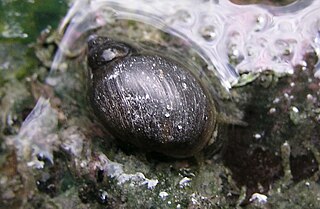
Caving – also known as spelunking in the United States and Canada and potholing in the United Kingdom and Ireland – is the recreational pastime of exploring wild cave systems. In contrast, speleology is the scientific study of caves and the cave environment.

The Dolloff cave spider is a spider native to California, among the rarest spiders of North America.
Spelaeorchestia koloana, the Kauaʻi cave amphipod or ʻuku noho ana in Hawaiian, is a cave-dwelling crustacean only found on the Hawaiian island of Kauaʻi. It is eyeless and measures 7–10 mm (0.28–0.39 in) long. It is only known from 10 populations, and eats decaying plant matter and other decomposing material.

Physella is a genus of small, left-handed or sinistral, air-breathing freshwater snails, aquatic pulmonate gastropod mollusks in the family Physidae.

Physella acuta is a species of small, left-handed or sinistral, air-breathing freshwater snail, an aquatic gastropod mollusk in the family Physidae. Common names include European physa, tadpole snail, bladder snail, and acute bladder snail. In addition, Physa acuta, Physa heterostropha and Physa integra are synonyms of Physella acuta.

The Banff Springs snail is a species of small air-breathing freshwater snail in the family Physidae.
Speleoperipatus is a monospecific genus of velvet worm in the Peripatidae family, containing the single species Speleoperipatus spelaeus. This species is a pale greenish yellow, almost white, with 22 or 23 pairs of legs and no eyes. Specimens range from 27 mm to 34 mm in length. The minimum number of leg pairs found in this species (22) is also the minimum number found in the neotropical Peripatidae. This velvet worm is viviparous, with mothers supplying nourishment to their embryos through a placenta.
The Fish Lake physa, scientific name Physella microstriata, was a species of air-breathing freshwater snail, an aquatic gastropod mollusk in the family Physidae.
The Snake River physa snail, scientific name Physella natricina, is a species of freshwater snail, an aquatic gastropod mollusk in the family Physidae. This species is endemic to Idaho in the United States.
The Utah physa, scientific name Physella utahensis, is a species of freshwater snail, an aquatic gastropod mollusk in the family Physidae. The common name refers to the state of Utah.
The Wet rock physa, scientific name Physella zionis, is a species of freshwater snail, an aquatic pulmonate gastropod mollusc in the family Physidae, the bladder snails. This species is endemic to two connected canyons, Zion Canyon and Orderville Canyon, along the north fork of the Virgin River in Zion National Park, Washington County, Utah, a stretch of about 5 kilometers (3.1 mi).

Allocrangonyx is a genus of troglobitic amphipod crustaceans from the South Central United States. The two species are both listed as vulnerable on the IUCN Red List. The animals are blind and unpigmented. During the male's development, the outer ramus of the third uropod differentiates into secondary segments and grows to a length greater than the animal's body length.
Caecidotea nickajackensis is a species of isopod crustacean in the family Asellidae. It was believed to be endemic to a single cave in Tennessee, and was thought to have been exterminated when that cave was flooded in 1967 by the building of the Nickajack Dam, however, in 2013 the species was discovered within Horseskull Cave and Raccoon Mountain Caverns.
Mexistenasellus is a genus of isopod crustaceans in the family Stenasellidae.
Niphargobates is a genus of amphipod crustaceans containing two species from European caves. Niphargobates lefkodemonaki is only known to occur in a cave near Xyloskalo in the Lefka Ori mountains, Crete, Greece. Niphargobates orophobata is only known to occur in caves near Postojna, Slovenia. Both species are listed as vulnerable on the IUCN Red List.

Platycopiidae is a family of copepods. Until the description of Nanocopia in 1988, it contained the single genus Platycopia. It now contains four genera, three of which are monotypic; the exception is Platycopia, with 8 species.






